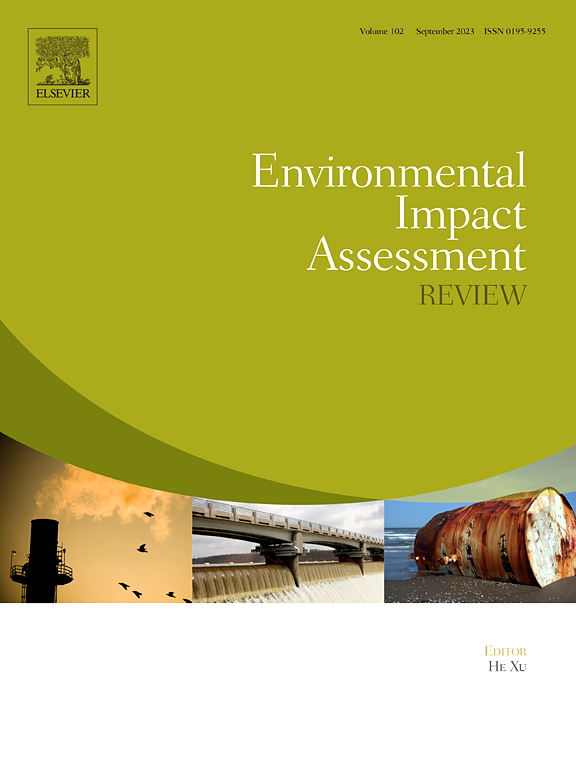中等保护情景下2000 - 2050年青藏高原社会生态系统脆弱性持续降低
IF 9.8
1区 社会学
Q1 ENVIRONMENTAL STUDIES
引用次数: 0
摘要
近几十年来,社会生态系统(SESs)内部相互作用和压力不断加剧,导致环境退化和社会经济发展不平衡等多方面的挑战趋同。尽管脆弱性评估在为气候准备战略提供信息和制定适应性治理框架方面至关重要,但通过历史基线和未来气候预测的综合SES视角对社会生态系统脆弱性(SEV)进行综合评估的学术关注有限。为解决这一问题,我们构建了一个SEV综合评估框架,并对2000 - 2020年青藏高原地区SEV的时空动态进行了探讨。采用随机森林模型预测了2030-2050年3种未来情景(SSP1-2.6、SSP2-4.5和SSP3-7.0)下的脆弱性轨迹。地理空间分析显示,在历史条件和模拟未来情景下,青藏高原的SEV分布具有明显的纬度梯度,从东南部高植被区到西北部干旱区,脆弱性水平逐渐增加。从时间上看,研究期间的总脆弱性降低了1.38%,特别是在东部地区。正向预估表明,所有情景下的脆弱性缓解都在加速,SSP2-4.5温和气候轨迹显示出最佳结果——预计到2050年,极端脆弱性地区将减少到12.66%,比2020年基线水平减少9.26%,同时在整个预估窗口保持一致的下降趋势。这种方法上的创新为区域尺度的SEV量化提供了一个可转移的框架,使基于证据的SES管理决策成为可能。针对特定情景的脆弱性预测为优化减少灾害风险战略和加强气候适应途径提供了重要见解,对面临加速变暖趋势的高海拔生态系统尤其重要。我们的研究结果强调了综合生态保护措施和可持续发展举措在缓解不断变化的气候制度下的社会生态风险方面的协同潜力。本文章由计算机程序翻译,如有差异,请以英文原文为准。

Continuous reduction in socio-ecological system vulnerability on the Qinghai–Tibet Plateau from 2000 to 2050 under an intermediate protection scenario
The intensifying interactions and pressures within socio-ecological systems (SESs) have precipitated a convergence of multifaceted challenges in recent decades, including environmental degradation and imbalanced socioeconomic development. Despite the critical importance of vulnerability assessments in informing climate preparedness strategies and formulating adaptive governance frameworks, limited scholarly attention has been directed toward comprehensive assessments of socio-ecological system vulnerability (SEV) through an integrated SES perspective across both historical baselines and future climate projections. To address this, we developed an integrative assessment framework for SEV and explored the spatiotemporal dynamics of SEV across the Qinghai–Tibet Plateau (QTP) from 2000 to 2020. Random forest models were employed to project vulnerability trajectories under three future scenarios (SSP1–2.6, SSP2–4.5, and SSP3–7.0) spanning 2030–2050. Our geospatial analyses revealed a distinct latitudinal gradient in SEV distribution across the QTP, with vulnerability levels progressively increasing from the southeastern high-vegetation regions to the northwestern arid zones under both historical conditions and modeled future scenarios. Temporally, the study period witnessed a 1.38 % reduction in aggregate vulnerability, particularly evident in the eastern region. Forward projections indicate accelerated vulnerability mitigation across all scenarios, with the SSP2–4.5 moderate climate trajectory demonstrating optimal outcomes - extreme vulnerability areas are projected to diminish to 12.66 % by 2050, representing a 9.26 % reduction from 2020 baseline levels, while maintaining consistent downward trends throughout the projection window. This methodological innovation provides a transferable framework for regional-scale SEV quantification, enabling evidence-based policymaking for SES management. The scenario-specific vulnerability projections offer critical insights for optimizing disaster risk reduction strategies and enhancing climate adaptation pathways, particularly crucial for high-altitude ecosystems facing accelerated warming trends. Our findings underscore the synergistic potential of integrated ecological conservation measures and sustainable development initiatives in mitigating socio-ecological risks under evolving climate regimes.
求助全文
通过发布文献求助,成功后即可免费获取论文全文。
去求助
来源期刊

Environmental Impact Assessment Review
ENVIRONMENTAL STUDIES-
CiteScore
12.60
自引率
10.10%
发文量
200
审稿时长
33 days
期刊介绍:
Environmental Impact Assessment Review is an interdisciplinary journal that serves a global audience of practitioners, policymakers, and academics involved in assessing the environmental impact of policies, projects, processes, and products. The journal focuses on innovative theory and practice in environmental impact assessment (EIA). Papers are expected to present innovative ideas, be topical, and coherent. The journal emphasizes concepts, methods, techniques, approaches, and systems related to EIA theory and practice.
 求助内容:
求助内容: 应助结果提醒方式:
应助结果提醒方式:


